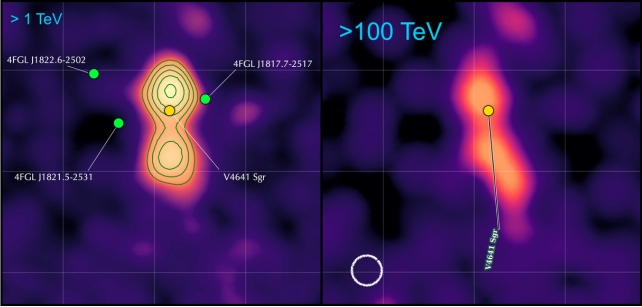Scientists have lengthy thought that the highest-energy gamma rays in area are cast within the intense furnaces of very lively supermassive black holes, far, distant. However a brand new research has traced a few of these high-energy photons to an object a lot nearer to us.
V4641 Sagittarii is a system about 20,000 light-years from Earth, within the course of the constellation Sagittarius. There, a black gap with the mass of about six Suns is slurping materials off a large star of about three photo voltaic plenty – and producing intense radiation like a cosmic particle accelerator.
Astronomers have now detected photons from V4641 Sagittarii carrying energies of as much as a staggering 200 teraelectronvolts (TeV). For reference, that is 200 trillion instances extra power than seen gentle, and among the many highest-energy photons you may discover out in area.
Gamma rays round this power stage are recognized to zip across the cosmos, however scientists thought they largely originated in quasars – brilliant galactic cores, by which supermassive black holes launch enormous quantities of power as they messily chow down on in-falling fuel.
V4641 Sagittarii is what’s referred to as a microquasar, and because the title suggests, it form of capabilities like a mini model of an everyday quasar. The black gap is smaller, the matter supply is smaller, and the radiation they emit is smaller. Or at the very least, that is what typical considering instructed us.
“Photons detected from microquasars have often a lot decrease energies than these from quasars,” says Sabrina Casanova, of the Institute of Nuclear Physics Polish Academy of Sciences (IFJ PAN).
“Normally, we’re speaking about values of the order of tens of gigaelectronvolts. In the meantime, now we have noticed one thing fairly unbelievable within the information recorded by the detectors of the [High-Altitude Water Cherenkov] observatory: photons coming from a microquasar mendacity in our galaxy, and but carrying energies tens of hundreds of instances greater than typical.”
Situated on the aspect of the extinct Sierra Negra volcano in Mexico, the HAWC gamma-ray observatory is designed to select up notably high-energy particles streaming in from area. To take action, it is made up of 300 large metal tanks, filled with purified water.
The thought is, when these high-energy particles enter a tank, they set off a cascade of different particles that journey via the water quicker than gentle does. This creates a flash of sunshine known as Cherenkov radiation, which is actually the electromagnetic model of a sonic increase.
Delicate detectors lining the within of the tanks choose up these flashes, and permit scientists to work backwards to determine what sort of charged particle set it off, and which course it got here from.
HAWC can see 15 p.c of the sky at any given time, and can scan two-thirds of the entire sky each 24 hours, build up a form of cosmic map. It was in certainly one of these maps that V4641 Sagittarii appeared as an surprising brilliant spot of gamma rays.
“Whereas reviewing the sky maps looking for my subsequent venture, I observed a area 5 levels away from our galactic aircraft with brilliant emissions that had not been seen in earlier datasets,” says physicist Xiaojie Wang.
“No gamma-ray supply has been recognized nor analyzed on this area – so I seized the chance and led the evaluation.”

On nearer inspection, V4641 Sagittarii was discovered to be the supply of those extremely high-energy gamma rays. Different microquasars, like SS 433, have beforehand been detected throwing off photons at energies of over 25 TeV, however V4641 Sagittarii is next-level: it was producing radiation on par with common quasars, a feat beforehand thought inconceivable.
The brand new discovery provides astronomers a greater understanding of not simply cosmic radiation, however quasars themselves. The physics round these enormous objects performs out in gradual movement, over tens of millions of years – however microquasars do related processes on timescales of days. They’re like pure simulators.
The analysis was printed within the journal Nature.





